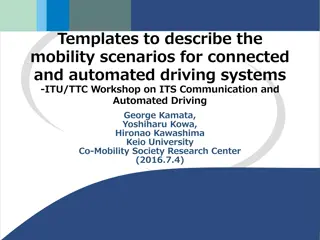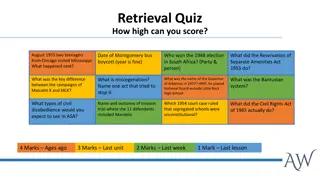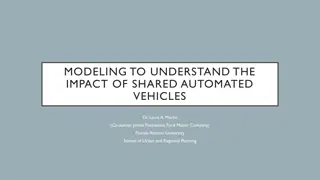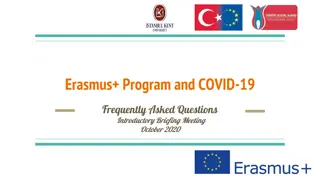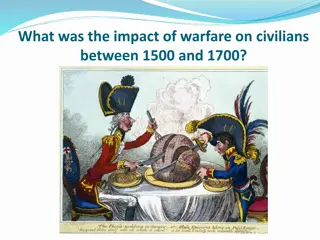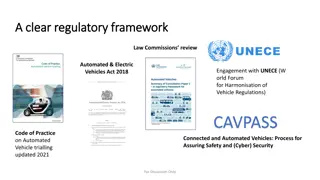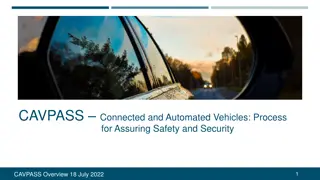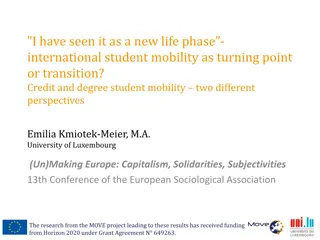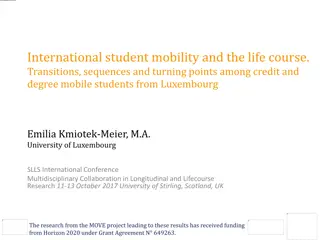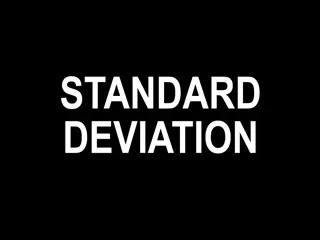
Enhancing Emerging Technologies Through Standardisation
This article explores the significance of standardisation in supporting emerging technologies, particularly in connected and automated mobility. It discusses the benefits of standardisation, highlights the role of standards in innovation and safety, and provides insights into the CAV Standards Programme in the UK. Emphasizing the importance of coordination, quality infrastructure, and resource allocation, the article underscores how standardisation plays a crucial role in promoting innovation, interoperability, and market growth.
Download Presentation

Please find below an Image/Link to download the presentation.
The content on the website is provided AS IS for your information and personal use only. It may not be sold, licensed, or shared on other websites without obtaining consent from the author. If you encounter any issues during the download, it is possible that the publisher has removed the file from their server.
You are allowed to download the files provided on this website for personal or commercial use, subject to the condition that they are used lawfully. All files are the property of their respective owners.
The content on the website is provided AS IS for your information and personal use only. It may not be sold, licensed, or shared on other websites without obtaining consent from the author.
E N D
Presentation Transcript
Connected and Automated Mobility standards David Webb March 25 Draft
Contents 1. The benefits of standardisation 2. The CAV Standards programme so far 3. Publicly Available Specifications (PASs) 4. The Role of Standards 5. Current catalogue 2
The Role of Standards The Role of Standardisation in Support of Emerging Technologies in the UK, BEIS Research Paper Number 2022/004 Key recommendations: 1. Deepening and enhancing coordination across the UK s National Quality Infrastructure (which includes BSI) and with Innovate UK (and Government more generally). 2. Building standardisation into the design process of public innovation programmes 3. Leveraging existing structures to promote and raise awareness of standards 4. Ensuring relevant processes are in place to identify standardisation needs 5. Ensuring relevant processes are in place to develop standards in innovative areas 6. Increasing the dedicated resources available for standardisation activities 3
The benefits of standardisation The beneficial impacts that standardisation has on innovation in emerging technologies: Codifying knowledge where the information set out in standards can serve as an input for further innovation and also help to coordinate innovation activities both within and between organisations, and where standards can help to communicate information about product characteristics to potential users and consumers that then helps to foster sales Reducing the variety of options which in emerging areas can enable economies of scale and critical mass, as well as cohesion in a sector as the basis for market growth, while also incentivising incremental innovation and investment in complementary infrastructure Defining minimum levels of quality including the intention to protect safety. Minimum levels of quality can help to create trust among early adopters of emerging technologies and avoid incidents that undermine trust in new products, as well as avoid Gresham s Law (where low-quality products can drive out high quality goods in markets where there are high levels of information asymmetry) Supporting interoperability with positive network externalities incentivising innovation. The definition and implementation of relevant standards ensures compatibility and interoperability of components by different suppliers. 4
The CAV Standards programme so far The CAV Standards Programme enables UK industry to push forward the area of safety and security assurance, building on the experience of organisations and the desire from Government to ensure that CAM development, testing, trialling and deployment in the UK is as safe as reasonably practicable. 2019 2021 The initial focus was to develop standards that would support the safety of AV development and trials This was built upon through further standards to support positioning the UK as a leader in assessing the safety of trials Then an iterative standard (a Flex) which brings together a coherent taxonomy of the language used in the CAM domain 2021 - 2022 Additional guidelines on safety operators in automated vehicle testing and trialling Revisions of existing series. 5
Publicly Available Specification (PAS) A PAS is a fast-track standardization document Government must balance the limits of being able to introduce new legislation quickly with the pace of industry and CAM development. Fast-track standardisation allows the UK to stay agile to CAM technology development whilst ensuring CAM safety and security are prioritised throughout, with right-size oversight from government. Typically 12 months, instead of years for International Standards Flex Flexible way to develop consensus-based good practice with agility. Flex s can be iterated rapidly. New versions can be created in just a few weeks to months 6
Current catalogue PAS 1880 - Developing and Assessing Control Systems for Automated Vehicles PAS 1881 - Assuring the operational safety of automated vehicles PAS 1882 - Data collection and management for automated vehicle trials for the purpose of incident investigation PAS 1883 - Operational Design Domain taxonomy for an automated driving system PAS 1884 - Safety operators in automated vehicle testing and trialling PAS 1885 - The fundamental principles of automotive cyber security. Flex 1890 - CAV Vocabulary Flex 1889 Natural Language description for Abstract Scenarios for ADS CAV Standards Roadmap and exploratory tools 7






